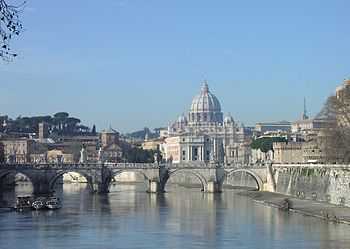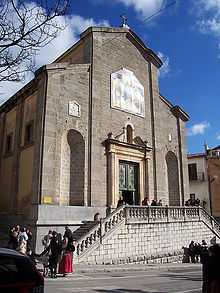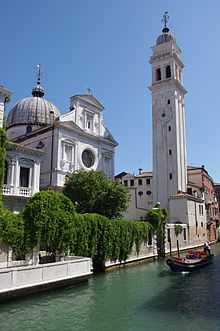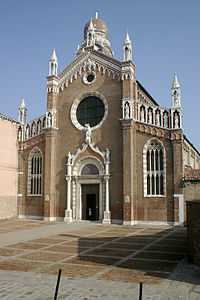Religion in Italy




Religion in Italy is characterised by the predominance of Christianity, especially the Catholic Church, and an increasing diversity of religious practices, beliefs and denominations.
The country's Catholic patron saints are Francis of Assisi and Catherine of Siena.[1]
Overview
According to the 2012 Global Religious Landscape survey by the Pew Forum on Religion and Public Life, 83.3% of Italy's residents are Christians, 12.4% are irreligious, atheist or agnostic, 2% are Muslims and the remaining 0.6% adhere to other religions.[2] According to a 2006 survey by Eurispes, Catholics made up 87.8% of the population, with 36.8% describing themselves as observants.[3] According to the same poll in 2010, those percentages fell to 76.5% and 24.4%, respectively.[4] Other sources give different accounts of Italy's Islamic population, usually around 2%.[5][6][7]
According to the 2005 Eurobarometer poll, 74% of Italians "believe there is a God", 16% "believe there is some sort of spirit or life force" and 6% "do not believe there is any sort of spirit, God, or life force".[8]
Catholic Church and minor historical denominations
Italy is home to the spiritual centre (see Holy See and Vatican City) of the 1.2-billion strong Catholic Church, whose world leader, the Pope, is the Bishop of Rome, hence the special relationship between Italians and the Church—and the latter's entanglement with Italian politics (see Lateran Treaty). The current Pope is Francis, born Jorge Mario Bergoglio, who, before his election in 2013, had been Archbishop of Buenos Aires since 1998. Francis is the third non-Italian Pope in a row, after John Paul II (1978–2005) and Benedict XVI (2005–2013). Most of the leading Catholic religious orders, including the Jesuits, the Salesians, the Franciscans, the Capuchin Franciscans, the Benedectines, the Dominicans, the Divine Word Missionaries, the Redemptorists, the Conventual Franciscans and the Oblates of Mary Immaculate, have their headquarters in Rome too.[9]
The Italian territory is divided in 225 Catholic dioceses and, according to Church statistics, 96% of the country's population is baptised.[10] Ecclesial life is vibrant and, despite secularization, some of the most active movements and associations are Catholic, including organisations as diverse as Catholic Action, the Italian Catholic Association of Guides and Scouts, Communion and Liberation, Neocatechumenal Way, the Focolare Movement, the Christian Associations of Italian Workers, the Community of Sant'Egidio, etc., most of which frequently supplied Italian politics with their members.
Other than the mighty Catholic Church, Italy has two more native churches: the Italo-Albanian Catholic Church, one of the 22 Eastern Churches in communion with the Pope, and the Waldensian Evangelical Church, a Christian movement originated from Lyon in the late 1170s and turned Calvinist denomination since the Protestant Reformation. The two churches include the majority of the local population in Piana degli Albanesi, Sicily and Lungro, Calabria, and the so-called "Waldensian Valleys" (Val Pellice, Val Chisone and Valle Germanasca) of eastern Piedmont, respectively.
Most mainline Protestants, including the Waldensians, the Methodists, the mostly German-speaking Lutherans, the Baptists and minor Calvinist and Presbyterian communities, are affiliated to the Federation of Evangelical Churches in Italy, along with the Italian section of The Salvation Army and some minor evangelical and Pentecostal denominations.[11]
Italy is home to around 45,000 Jews,[12] who are one of the most ancient Jewish communities in the world. The Jewish presence dates to the pre-Christian Roman period and has continued, despite periods of extreme persecutions and expulsions from parts of the country from time to time, until the present. The native Italian Jews, who form the core of the community in Rome, practice the Italian rite, while there are also Ashkenazi Jews, who have settled in the North, especially the Republic of Venice and Piedmont, since the late Middle Ages, and Sephardi Jews, who established themselves mostly in Livorno, Florence, Venice and the cities of Emilia, after their expulsion from the Kingdom of Naples.[13] The Jewish community of Milan, notably including a substantial number of Mizrahi Jews originating from the Middle East, is the most international in character and composition.[14]
Freedom of religion and agreements with denominations
The Constitution of Italy recognises the state and the Catholic Church as "independent and sovereign, each within its own sphere" (art. 7). In particular, the Lateran Treaty of 1929, which gave a special status to the Catholic Church, is recognised and modifications "accepted by both parties" to such treaty are allowed without the need of constitutional amendments. In fact, the treaty was later modified by a new agreement between the state and the Church in 1984. Freedom of religion is also recognised, with "all religious denominations" having "the right of self-organisation according to their own statutes, provided these do not conflict with Italian law"; "[t]heir relations with the state are regulated by law, based on agreements with their respective representatives" (art. 8).[15]
As of 2014, the Italian government has signed twelve such agreements and eleven have been approved by the Italian Parliament and signed into law, including those with the following denominations:[16]
- Union of Methodist and Waldensian Churches (1984; modified in 1993 and 2007/2009);
- Evangelical Christian Churches Assemblies of God in Italy (1986/1988);
- Italian Union of Seventh-day Adventist Christian Churches (1986/1998; modified in 1996 and 2007/2009);
- Union of Jewish Communities in Italy (1987/1989; modified in 1996);
- Evangelical Reformed Baptist Churches in Italy (1993/1995; modified in 2010, not yet signed into law);
- Lutheran Evangelical Church in Italy (1993/1995);
- Holy Orthodox Archdiocese of Italy and Exarchate of Southern Europe (2007/2012);
- Church of Jesus Christ of Latter-day Saints in Italy (2007/2012);
- Apostolic Church in Italy (2007/2012);
- Italian Buddhist Union (2007/2012);
- Italian Hindu Union (2007/2012);
- Christian Congregation of Jehovah's Witnesses in Italy (endorsed in 2007, not yet signed into law).
Both Waldensians and Jews have played an important role in Italian politics and have been quite represented in legislative bodies. While there have been many Catholic-inspired parties, from Christian Democracy (DC) to Forza Italia, Waldensians have been usually active in "secular" parties and, more recently, a group of Pentecostals set up the Extended Christian Pact party.
Statistics on religious practice
Religious practice is still high in Italy, whether compared to the average European country.
The Italian National Institute of Statistics (ISTAT) found in 2010 that 32.0% of the population went to church, mosque, synagogue or another house of worship on a weekly basis. The share of practising believers was higher in Southern (39.5%) and Insular Italy (36.9%) than the North-West (30.4%), the North-East (28.6%) and the Centre (25.4%).
In the North-East religious practice was particularly high in Trentino (36.6%) and Veneto (35.1%), once dubbed "white Veneto" because of Christian Democracy's strength there (the white being DC's official colour), in the Centre in Marche (35.5%), in the South in Campania (43.4%), Apulia (40.3%), Sicily (40.2%), Molise (37.8%) and Calabria (35.2%), while being particularly low in Aosta Valley (21.7%), Liguria (22.9%) and the so-called "red regions" (long-time strongholds of the left, from the Italian Communist Party to the current Democratic Party), especially Tuscany (21.5%) and Emilia-Romagna (21.7%).[17][18]
Immigration and demographic scenarios
Immigration has brought to Italy many religious minorities, especially Muslims and Orthodox Christians.
Massimo Introvigne, founder and director of CESNUR, an Italian think tank devoted to religious studies, and main author of L'enciclopedia delle religioni in Italia, predicts that, thanks to continued immigration from Eastern Europe, Orthodox Christians could soon become the second largest religious group, overtaking Muslims. Also Protestantism, especially in its evangelical and Pentecostal forms, is on the rise: Introvigne recalls how Giorgio Bouchard, a Waldensian pastor, told him that "when he was born, the typical Italian Protestant was a man, lived in Piedmont, had a last name like Bouchard and was a Waldensian", while "today, the typical Italian Protestant believer is a woman, lives in Campania or Sicily, is named Esposito and is a Pentecostal."[19] Not surprisingly the Assemblies of God have the majority of their communities in the South.[20]
Among the fastest-growing new religious denominations in Italy a special place is held by the Jehovah's Witnesses, who count around 250,000 members and an almost equal number of symphatisers regularly attending its meetings.[21]
According to Caritas Italiana, in 2010 the immigrant population was 53.9% Christian, 32.9% Muslim, 2.6% Hindu and 1.9% Buddhist.[22] According to the same source, in 2012 Italy was home to 850 "African Neo-Pentecostal churches", 750 foreign-language Catholic communities, 655 mosques or other Islamic houses of worship, 355 Orthodox parishes, 126 Buddhist temples, 37 Sikh ones and 2 Hindu ones.[23] The Mosque of Rome is Europe's largest.[24]
Demography
This is a scheme of the religious composition of Italian population (58,751,711 – 2006, estimated):
- Christians: 53,800,000 (91.6%)
- Catholics: 51,600,000 (87.8%)
- Latin Rite Catholics: 51,500,000 (87.6%)
- Eastern Rite Catholics: 100,000 (0.2%)
- Italo-Albanians: 60,000 (0.1%)[25]
- Others (Romanian Greek Catholics, Ukrainian Greek Catholics, Armenian Catholics, etc.): 40,000 (0.07%)
- Other Christians: 2,200,000 (3.8%)
- Eastern and Oriental Orthodox: 950,000 (1.6%)[26]
- Romanian Orthodox: 500,000 (0.85%)
- Ukrainian Orthodox of the Moscow Patriarcate, the Kyivan Patriarcate or the Ukrainian Autocephalous Orthodox Church: 180,000 (0.31%)
- Others (Moldovan Orthodox, Greek Orthodox, Macedonian Orthodox, Serbian Orthodox, Bulgarian Orthodox, Russian Orthodox, Ethiopian Orthodox, Coptic Orthodox, Armenian Apostolics, Syriac Orthodox, Eritrean Orthodox, etc.): 180,000 (0.46%)
- Anglicans: 50,000 (0.08%)
- Protestants: 725,000 (1.3%)
- Evangelicals and Pentecostals: 550,000 (0.94%)
- Assemblies of God: 400,000 (0.68%)
- Others: 150,000 (0.25%)
- Mainline Protestants: 175,000 (0.20%)[27][28]
- Waldensians and Methodists: 57,000 (0.09%)
- Waldensians: 50,000 (0.08%)
- Methodists: 7,000 (0.01%)
- Seventh-day Adventists: 25,000 (0.04%)
- Baptists: 20,000 (0.03%)
- Brethren: 20,000 (0.03%)
- Lutherans: 8,000 (0.01%)
- Waldensians and Methodists: 57,000 (0.09%)
- Others (Disciples of Christ, Presbyterians, other Calvinists, Mennonites, etc.): 30,000 (0.05%)
- Evangelicals and Pentecostals: 550,000 (0.94%)
- Jehovah's Witnesses: 500,000 (0.85%)
- Latter-day Saints: 25,000 (0.04%) [29]
- Eastern and Oriental Orthodox: 950,000 (1.6%)[26]
- Catholics: 51,600,000 (87.8%)
- Muslims: 1,130,000 (1.9%)[26]
- Buddhists: 160,000 (0.3%)[26]
- Hindus: 115,000 (0.2%)[26]
- Sikhs: 70,000[30] (0.1%)
- Jews: 45,000 (0.1%)
- Bahá'ís: 4,900[31]
- Federation of Damanhur: >1000
- No Religion: 3,400,000 (5.8%)
| Part of a series on the |
| Culture of Italy |
|---|
 |
| History |
| People |
| Languages |
| Traditions |
| Cuisine |
| Festivals |
| Religion |
| Art |
| Literature |
|
Music and performing arts |
| Sport |
|
See also
- Freedom of religion in Italy
- History of Roman Catholicism in Italy
- History of the Jews in Italy
- Christianity in Italy
- Orthodoxy in Italy
- Protestantism in Italy
- Islam in Italy
- Bahá'í Faith in Italy
- Buddhism in Italy
- Hinduism in Italy
- Sikhism in Italy
- List of Italian religious minority politicians
- Federation of Evangelical Churches in Italy
References
- ↑ http://www.vatican.va/holy_father/pius_xii/briefs/documents/hf_p-xii_brief_19390618_patroni-italia_it.html
- ↑ http://www.pewforum.org/files/2014/01/global-religion-full.pdf
- ↑ Corriere della Sera - Italia, quasi l'88% si proclama cattolico
- ↑ http://cronachelaiche.globalist.it/Detail_News_Display?ID=20167
- ↑ http://www.arcre.org/wp-content/uploads/2012/12/Islam-en-Italie-31975971.pdf
- ↑ http://ssai.interno.it/download/allegati1/instrumenta_25_09_-_spreafico_%28da_pag._1_a_40%29.pdf
- ↑ http://www.linkiesta.it/quanti-sono-e-cosa-vogliono-i-musulmani
- ↑ ReportDGResearchSocialValuesEN2.PDF
- ↑ "Religious Orders". Catholic-Hierarchy.org. David M. Cheney. Retrieved 21 January 2015.
- ↑ "Statistics by Country". Catholic-Hierarchy.org. David M. Cheney. Retrieved 21 January 2015.
- ↑ http://www.fedevangelica.it/fcei/fcei04.php
- ↑ http://www.ajcarchives.org/AJC_DATA/Files/AJYB727.CV.pdf
- ↑ http://www.cesnur.com/lunione-delle-comunita-ebraiche-italiane/
- ↑ http://archiviostorico.corriere.it/2000/settembre/01/Gli_ebrei_aprono_sinagoga_co_7_0009017854.shtml
- ↑ http://www.senato.it/documenti/repository/istituzione/costituzione_inglese.pdf
- ↑ http://www.governo.it/Presidenza/USRI/confessioni/intese_indice.html
- ↑ http://dati.istat.it/
- ↑ http://corrieredelmezzogiorno.corriere.it/napoli/notizie/arte_e_cultura/2011/15-luglio-2011/sud-napoli-non-piu-capitale-laicaa-catania-piu-si-al-sindaco-1901095132049.shtml
- ↑ http://vaticaninsider.lastampa.it/inchieste-ed-interviste/dettaglio-articolo/articolo/religioni-religion-24785/
- ↑ http://www.assembleedidio.org/dovesiamo.php
- ↑ http://www.cesnur.com/i-testimoni-di-geova-e-i-loro-scismi/i-testimoni-di-geova/
- ↑ http://www.caritasitaliana.it/materiali/Pubblicazioni/libri_2011/dossier_immigrazione2011/scheda_religioni.pdf
- ↑ http://www.chiesacattolica.it/cci_new_v3/allegati/53507/SINTESI%20XXIII%20Rapporto%20Immigrazione.pdf
- ↑ http://www.sotterraneidiroma.it/tours-visite-guidate-sdr/item/la-moschea-di-roma
- ↑ Italy, Statistics by Diocese, by Catholic Population [Catholic-Hierarchy]
- ↑ 26.0 26.1 26.2 26.3 Caritas Dossier Immigrazione 2007
- ↑ Chiesa Evangelica Valdese - Unione delle chiese Metodiste e Valdesi
- ↑ http://www.chiesabattistadiconversano.it/i_protestanti_in_italia.html
- ↑ http://www.mormonnewsroom.org/facts-and-statistics/country/italy
- ↑ http://www.nriinternet.com/EUROPE/ITALY/2004/111604Gurdwara.htm
- ↑ "Most Baha'i Nations (2005)". QuickLists > Compare Nations > Religions >. The Association of Religion Data Archives. 2005. Retrieved 2010-01-30.
| ||||||||||||||||
| ||||||||||||||||||||||||||||||||||||||||||||
| ||||||||||||||||||